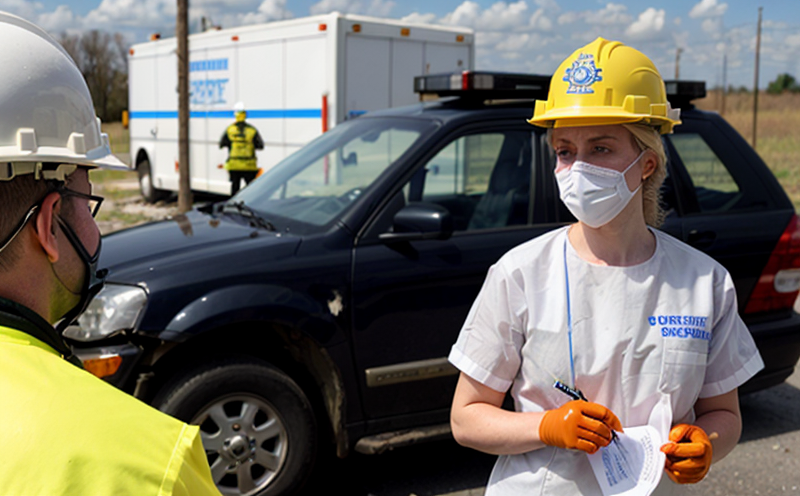ISO 2889 Airborne Radioactivity Sampling in Nuclear Accidents
The International Organization for Standardization (ISO) has developed ISO 2889:2014, a standard that provides guidelines and procedures for the sampling of airborne radioactive materials during nuclear accidents. This service ensures accurate and reliable measurement, which is critical in mitigating health risks and environmental impacts.
The standard applies to air samples collected under conditions where there are elevated levels of radioactivity due to an accident at a nuclear facility or other similar scenarios. It aims to provide a consistent methodology for sampling, analyzing, and reporting airborne radioactive materials, ensuring that the data can be used reliably in decision-making processes by regulatory bodies.
The primary audience for this service includes quality managers, compliance officers, R&D engineers, and procurement professionals responsible for managing health and safety risks associated with nuclear accidents. The standard is particularly relevant to organizations involved in emergency response, environmental monitoring, and public health protection.
The ISO 2889 protocol focuses on the collection of air samples using specific sampling devices designed to capture airborne radioactive particles accurately. These devices are calibrated according to international standards such as ISO/IEC 17025 for calibration laboratories and ASTM E630-18 for aerosol samplers.
The sampling process involves the use of specialized filters or collectors that can capture radioactive particles efficiently. These samples are then analyzed using sensitive detectors such as gamma spectrometers, alpha scintillation counters, and beta-gamma coincidence spectrometers to quantify the radioactivity levels.
The standard emphasizes the importance of proper sample preparation and handling to avoid contamination and ensure accurate results. This includes the use of personal protective equipment (PPE) for sampling personnel, the placement of samples in appropriate containers, and the transportation of samples under controlled conditions.
One critical aspect of ISO 2889 is its requirement for the documentation and reporting of all aspects of the sampling process. This ensures transparency and accountability, allowing regulatory bodies to verify the accuracy and reliability of the data collected.
The standard also addresses the need for ongoing training and certification of personnel involved in airborne radioactivity sampling. This helps maintain high-quality standards across different facilities and jurisdictions.
By adhering to ISO 2889, organizations can ensure that they are meeting international best practices in radiation protection, which is essential during nuclear accidents or other similar events.
Scope and Methodology
| Aspect | Description |
|---|---|
| Sampling Device | The standard specifies the use of specialized aerosol samplers designed to capture airborne radioactive particles. These devices are calibrated according to international standards. |
| Sampling Location | Sampling should be conducted at strategic locations that provide a representative sample of the ambient air. |
| Sample Preparation | samples must be prepared in accordance with ISO 2889 to ensure accuracy and consistency. This includes the use of appropriate containers and transport conditions. |
| Analytical Methods | The standard recommends the use of gamma spectrometry, alpha scintillation counting, and beta-gamma coincidence spectrometry for quantifying radioactivity levels in samples. |
| Data Reporting | All aspects of the sampling process must be documented and reported. This includes details on sample collection, transport, storage, and analysis. |
The methodology outlined in ISO 2889 ensures that air samples are collected accurately and analyzed reliably, providing a robust framework for emergency response and accident dose assessment testing.
Customer Impact and Satisfaction
The implementation of ISO 2889 can significantly impact customers by ensuring that they are equipped with the most accurate and reliable data for decision-making during nuclear accidents. This leads to improved health outcomes, reduced environmental impacts, and enhanced public trust.
Clients will benefit from this service through:
- Enhanced Safety: Accurate sampling helps in identifying potential risks early and implementing appropriate mitigation measures.
- Compliance with Regulations: The standard ensures that all procedures are aligned with international guidelines, reducing the risk of non-compliance penalties.
- Improved Reputation: By demonstrating a commitment to high-quality standards, organizations can enhance their reputation among stakeholders and regulators.
- Cost-Effective Solutions: Early identification of risks through accurate sampling can prevent costly delays and remediation efforts.
We strive to exceed customer expectations by providing exceptional service, timely delivery, and transparent communication. Our team of experts ensures that every aspect of the ISO 2889 protocol is followed rigorously.
Use Cases and Application Examples
The application of ISO 2889 extends to various scenarios where airborne radioactivity needs to be monitored. Some key use cases include:
- Nuclear Power Plant Incidents: After a nuclear power plant accident, air sampling helps in assessing the extent of contamination and guiding clean-up efforts.
- Environmental Monitoring: Continuous monitoring can help in understanding the spread of radioactive materials into the environment.
- Public Health Assessments: Accurate data is crucial for public health authorities to assess potential risks to the population.
- Regulatory Compliance: Ensuring compliance with international standards helps organizations meet regulatory requirements and avoid legal issues.
In each of these scenarios, ISO 2889 provides a standardized approach that ensures consistency and reliability in sampling and analysis. This is critical for effective emergency response and accident dose assessment testing.





